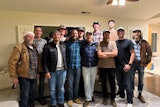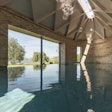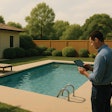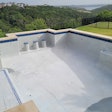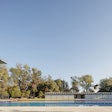
Back on January 17, 1994, a 6.7-magnitude earthquake, since dubbed the Northridge Quake, devastated the San Fernando Valley in Los Angeles. It caused more than $20 billion in damage. Fifty-seven people died and thousands more were injured.
In the disaster's aftermath, I was retained by the Superior Court of California in L.A. County as a forensic expert in a class-action lawsuit against a major insurance company. The plaintiffs claimed that a major insurance carrier had not properly processed 84 claims for swimming pools damaged in the quake. After I investigated approximately 60 pools, the insurance company settled the rest themselves.
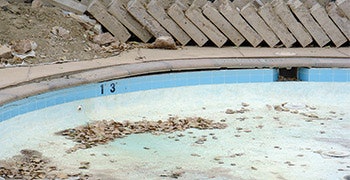 The failure pictured here and in the following images was the direct result of a rare soil condition known as hydro-consolidation, in which the soil collapses rather than expands when saturated.
The failure pictured here and in the following images was the direct result of a rare soil condition known as hydro-consolidation, in which the soil collapses rather than expands when saturated.
Although this may seem like ancient history, there's a lesson that remains just as relevant today as it was then. Of those 60 pools I inspected, none of them, not one, had been built with the benefit of a soils report!
All of the pools were residential and spread over an incredibly wide area, presumably in different types of soil conditions. The only thing they had in common was a complete lack of information about the ground into which they were built. It's also worth pointing out that commercial pools in the region, which almost always are engineered based on geotechnical information, suffered only minor damage, if any.
RUNNING TO GROUND
This experience reinforced what I had already believed for decades: Soils reports — and structural engineering based on those reports — are critical when it comes to ensuring the durability of the pool shell.
One big reason I'm so sure is that I've designed over 700 commercial pools the world over — all engineered based on soils reports — and not one of them has experienced a structural failure.
As most of us know, in the world of residential pools especially, structural failures are far from unusual. They happen more often than they should and the reason is brutally simple: When you endeavor to build structures that exist partially or completely in the ground, you absolutely must know the geological conditions. Otherwise, how do you know what to build?
When you leave it to chance or "educated" guessing, it's impossible to know whether or not the shell's reinforced concrete will withstand the forces it encounters.
That's an unacceptable level of risk, which is why I have steadfastly refused to move forward with any project unless we have the geotechnical issues completely addressed. It's just not worth it. I do realize many residential builders say paying for soils reports drives up cost and they can't compete against companies that don't use them. Unfortunately, that shortsighted thinking has been proven time and time again to be a prescription for disaster.
As long as builders skip the soils report, failures will continue with unacceptable frequency, and that's bad for the entire industry, not to mention our consumers.
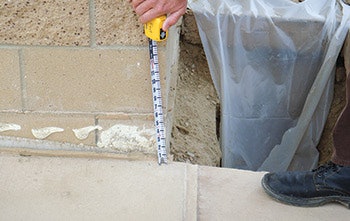 By failing to identify soil conditions before construction, this project suffered significant structural cracks to the pool shell - and the deck, coping and outdoor shower were completely destroyed.
By failing to identify soil conditions before construction, this project suffered significant structural cracks to the pool shell - and the deck, coping and outdoor shower were completely destroyed.
RISK AND EXPENSE
Here's another real-world example of why geotechnical engineering is so important:
There was another class-action suit back in the '90s that proved the same point about the peril of willful ignorance of soil conditions, albeit in a much different scenario than the Northridge Quake.
In this case, the "disaster" was entirely man-made.
It was in Laguna Niguel, Calif., a beautiful bedroom community about 60 miles south of L.A. The suit involved a massive upscale hillside development and a whopping 94 gorgeous luxury pools.
The houses had been built on cuts into virgin soil, but the pools behind them were all built on uncompacted fill. The developer provided geotechnical reports to the homeowners, none of whom realized they needed to pay any attention to that information. (Homeowners aren't construction professionals, and they simply didn't know that the reports were important when it came time to build their pools.)
Even though some builders argue that property owners are ultimately responsible for knowing the soil conditions, I find it unforgivable that the pool builders working in that development didn't think to ask their clients if soils information was available. They just jumped in and built all sorts of expensive custom pools, many with vanishing edges and other interesting elements, ignoring the possibility that the soil they were constructing in was partially or completely unstable.
Which it was. The result: as much as four inches of settlement in all 94 pools, resulting in structural failures and ultimately a class-action suit. It was an expensive mess that was completely avoidable. In hindsight, it's dizzying to think how much time, effort, frustration and money would've been saved if the builders had simply asked the owners for the needed information, which in this case was already available!
When we see failures on that scale, it becomes painfully apparent that there's a serious problem in the residential pool construction industry. There's a standard of care to which we should all aspire, whether working in the commercial or residential realms, and when you don't know the soil you are building in, you're simply not meeting a professional or legally defensible standard.
 The resulting renovation meant not only tearing out the entire pool and much of the surrounding structures, but also excavating the unstable soil and then adding compacted fill before the facility could be rebuilt. All of that time, expense and litigation could've been avoided with a proper soils report and geotechnical engineering.
The resulting renovation meant not only tearing out the entire pool and much of the surrounding structures, but also excavating the unstable soil and then adding compacted fill before the facility could be rebuilt. All of that time, expense and litigation could've been avoided with a proper soils report and geotechnical engineering.
HOW IT WORKS
Once you make a decision to work toward a professional standard, it's critical to approach the process with a basic understanding of exactly what structural engineers and geotechnical engineers do and how they do it. That awareness starts with the fact that the two professions are not the same.
Geotechnical engineering is concerned with construction on, in, or with the soil and rock. The structural engineer's focus is on the building/structure from the foundation to the roof. On the most basic level, both professions work toward the same end: making sure buildings and other structures remain standing and don't suffer damage from things like differential settlement, expansive soils or any number of other factors.
Before a building is constructed, a geotechnical engineer is retained (normally by the property owner, but it certainly can be a developer, general contractor or a pool builder) to investigate the soil and analyze its properties relative to supporting the proposed building or structure. That analysis might include fieldwork such as test pits, probing and boring along with a host of laboratory tests.
The geotechnical engineer's information is then put in a report and given to the structural engineer, who should not design a building or structure without this information. That report clarifies what type of soil is present on the site and explains whether it will expand or contract when wet, for example. (Expansive soil alone causes millions in damages to a range of structures every year.) The report will also look at bearing loads, groundwater, bedrock, seismic events, liquefaction, differential soil conditions, slope stability and a range of other potential factors.
The report may also include recommendations for the structural design based on those soil conditions. For example, if the soils collapse or expand when wet, the geotechnical engineer may recommend piles and/or a system of grade beams to support the structure. The report might also give specific recommendations for soil compaction or removal and replacement.
With all that information and possible recommendations in hand, the structural engineer can then design the structure to withstand the forces imparted by the soil conditions. For swimming pools, that can mean a number of design elements, including the thickness of the pool walls and floor, the size and amount of structural steel, the concrete's compaction strength, and, as mentioned just above, foundational support structures.
I know of no other way to ensure that the structure will last.
There are some structural engineers working in the pool industry that offer off-the-shelf standardized plans for residential pools, which is fine if they select the plan based, again, on geotechnical information. Unfortunately, the plan they often pull is instead based on loose assumptions about the soils in a given area, which may or may not be accurate.
There are many situations in which soil conditions change dramatically from property to property, or even within a given lot, as evidenced by the Laguna Niguel failures. Since the houses there were on load-bearing ground, it was assumed that the backyards were, too. Unfortunately, for those 94 homeowners, that was not the case.
Either you know what's under ground, or you don't. And unless you do, there is no way to be sure that the structure you're constructing will last.
|
|




















